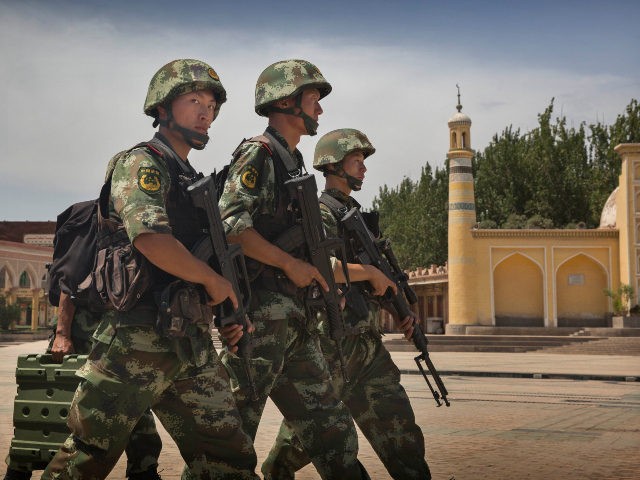Radio Free Asia (RFA) on Thursday took note of a Chinese government study that recommended building a second national capital in Xinjiang province to decisively “end the historical concept that the region is the Uyghur people’s motherland.”
The region is, in fact, the Uyghur people’s motherland, widely known as “East Turkistan” by the Uyghur Muslims and other Turkic minorities who have long dwelled there. The turbulent region was dominated by Chinese warlords in the early 20th Century, subdued as a satellite state by the Soviet Union in the 1940s, and finally invaded and annexed by Communist China in 1949. The name for the region imposed by China, “Xinjiang,” literally means “new territory.”
Many Uyghurs vehemently reject China’s assertions that it has an ancient claim to their land dating back almost 2,000 years. China, in turn, regards all talk of re-establishing an East Turkestan Republic – or even remembering that one used to exist – as seditious.
China’s brutal repression of the Uyghurs, a series of atrocities characterized as ethnic cleansing or outright genocide by international observers, was kicked into high gear by conjuring the specter of the East Turkestan Islamic Movement (ETIM).
ETIM was reportedly a real terrorist organization in the 1990s, responsible for a series of robberies and murders it committed with support from al-Qaeda and the Taliban of neighboring Afghanistan. The United Nations estimated ETIM never had more than about 200 operatives, and most counterterrorism experts believe the organization was effectively destroyed in 2010 with the death of its final leaders. The United States delisted the group as a terrorist organization in 2020 because there was “no credible evidence that ETIM continues to exist.”
This enraged Beijing, which claimed ETIM was vastly larger and more influential than any other nation realized and remained a major terrorist threat. Millions of Uyghurs were herded into concentration camps for torture and brainwashing on the grounds that ETIM and like-minded separatists lurked in every corner of Xinjiang.
Even before the Uyghurs were marched into re-education camps, China was attempting to colonize and ethnically cleanse East Turkestan by moving huge numbers of Han Chinese into the province, while the Uyghurs were atomized by shipping them off to distant corners of China as forced labor.
One reason China’s coronavirus lockdown policies ended with nationwide protests was that an apartment building in the East Turkestan capital of Urumqi caught fire and residents burned to death inside because the building was sealed and quarantined. The event became huge national news because so many appalled Han Chinese residents of Urumqi were on hand to witness it.
RFA reported on a paper published in a Chinese-language journal called “Social Sciences in Xinjiang” on April 21 that cited four years of economic and sociological research to conclude that building a new Chinese capital city somewhere near Urumqi, or possibly the western city of Kashgar, would both enhance China’s Belt and Road Initiative (BRI) ambitions in Central Asia and decisively squash East Turkestan’s sense of history and identity.
World Uyghur Congress vice president Erkin Ekrem told RFA the process of building such a city would go a long way toward erasing East Turkestan because China would aggressively “Sinicize” the region first, through such tactics as bringing in large numbers of Han Chinese workers to build necessary infrastructure.
“The Uyghur region is critical for China to achieve its dream. It is a gateway to Central Asia, Western Asia, Turkey and Europe. Therefore, establishing a secondary capital in the Uyghur region has strategic importance for China,” said Ekrem.
George Washington University international affairs professor Sean Roberts suggested China wants a bulwark against Central Asian instability spilling across its western border.
“If implemented, this would end the historical concept that this region is the Uyghur people’s motherland. I believe this also would accelerate the speed of Sinification in the area. This plan would change the entire landscape of the Uyghur Region and its relationship with the central government in Beijing,” Roberts said.
Center for Uyghur Studies Adbulhakim Idris had another idea: China might be interested in establishing a backup capital that would be harder for the Western world to attack if Beijing provokes a world war by invading Taiwan.
“If it moves its capital to our motherland, then it will be safer because it would be farther away from the U.S. Pacific Fleet,” he proposed.
The South China Morning Post (SCMP) reported China’s white paper was vague on the details of how a capital city could be constructed in the remote and forbidding terrain of East Turkestan, or exactly what functions it would perform, assuming its status as a “second national capital” was not purely symbolic.
In addition to subduing the Uyghurs (or, as the authors put it, making them feel more “included” in China’s authoritarian government) the paper asserted that building a second capital would relieve congestion and pollution in notoriously dirty Beijing, strengthen the Belt and Road Initiative’s links to Central Asia and even Europe, and help China exploit East Turkestan’s natural resources.
The SCMP observed that previous proposals have been made for China to establish a second capital, but existing tech and industrial hub cities like Guangzhou and Shanghai were the suggested locations. The new study recommending a capital in East Turkestan appears to be the most serious proposal to date.

COMMENTS
Please let us know if you're having issues with commenting.